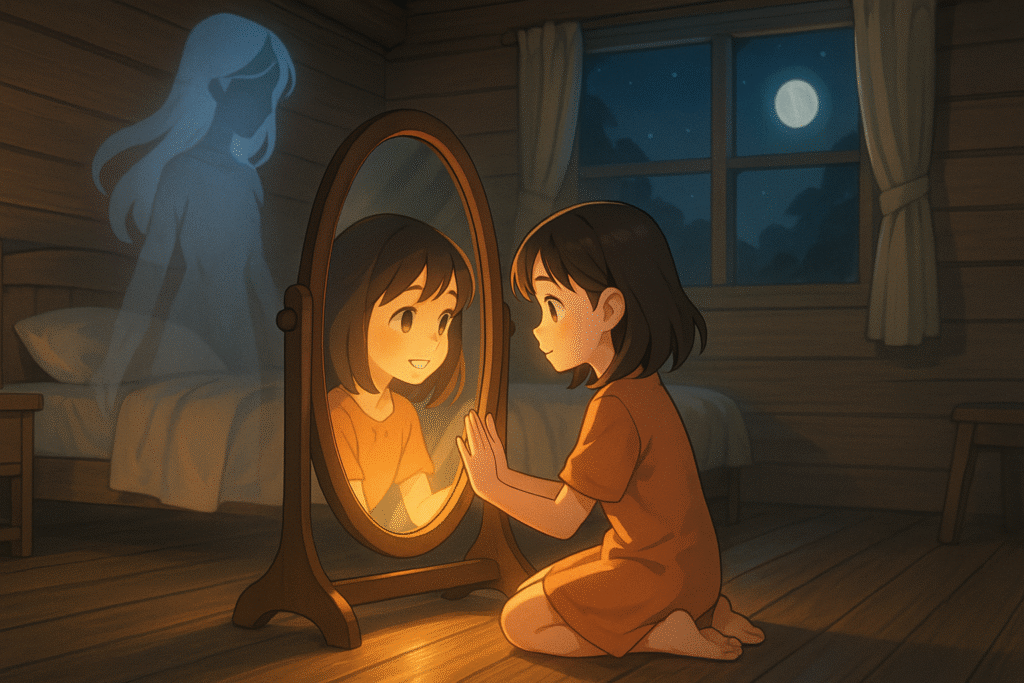In the rich tapestry of Japanese folklore, few stories capture the essence of familial bonds quite like “The Mirror of Matsuyama.” This ancient tale, set in the remote countryside of Japan, weaves together themes of love, loss, and the enduring connection between mother and daughter. As we explore this beautiful story, we’ll discover why it continues to resonate with readers across cultures and generations.
The Story of The Mirror of Matsuyama
Long ago in a secluded part of Japan lived a loving family: a hardworking father, his gentle wife, and their cherished daughter. When business called the father to distant Kyoto, he promised his daughter a special gift upon his return if she remained dutiful to her mother during his absence.
True to his word, when the man returned from his journey, he brought treasures for his family. For his daughter, he presented a beautiful doll and a lacquer box filled with sweet cakes. For his wife, he had something she had never seen before—a metal mirror with a shining surface and decorative pine trees and storks etched on its back.
The woman gazed in wonder at her reflection, initially believing she was seeing another person. After her husband explained the mirror’s purpose, she treasured it as a precious possession.
Not long after this joyful reunion, tragedy struck the family. The mother fell gravely ill, and as her final days approached, she called her beloved daughter to her bedside with these parting words:
“Dear child, after I am gone, take care of your father with all your heart. When loneliness finds you, take this mirror and look into it—there you will always see me.”
The Comfort of Reflection
Following her mother’s passing, the young girl honored her final request. In moments of sorrow, she would take out the cherished mirror and gaze into its surface. There, she saw what she believed was her mother’s face—not drawn with pain as in her final days, but youthful and beautiful, offering silent comfort.
Time passed, and eventually, the father remarried. Unfortunately, the new stepmother showed little kindness toward her stepdaughter. During these difficult times, the mirror became the girl’s greatest solace. She would retreat to quiet corners of the house, take out the mirror, and whisper softly to the reflection she saw.
One day, the stepmother discovered the child crouched in a corner, murmuring to an object hidden from view. Harboring suspicion and resentment, the woman immediately assumed the worst—that her stepdaughter was practicing witchcraft against her, perhaps creating a cursed doll or charm. Alarmed, she reported her fears to her husband.
Truth Revealed in The Mirror of Matsuyama
Troubled by his wife’s accusations, the father confronted his daughter unexpectedly. Startled by his sudden appearance, the girl quickly hid the mirror in her sleeve. When questioned about her behavior and the concealed object, she explained with innocent sincerity:
“Father, this is the mirror you gave to mother, which she entrusted to me before dying. Whenever my heart aches from loneliness or harsh words, I look into it and see mother’s face—young and beautiful—smiling kindly at me. Her reflection brings me peace and helps me endure difficult times.”
Upon hearing these words, the father’s suspicions melted away, replaced by understanding and deeper love for his daughter. Even the stepmother, learning the truth behind what she had witnessed, felt ashamed of her accusations and begged forgiveness, which the compassionate child readily granted. From that day forward, harmony returned to their home.
Cultural Significance of The Mirror of Matsuyama
The Mirror of Matsuyama stands apart from typical mirror folklore found across world cultures. While many traditions warn that mirrors can trap souls or serve as portals to other realms—usually with ominous consequences—this Japanese tale transforms the potentially supernatural element into a source of comfort and connection.
In Japanese culture, where respect for parents and ancestors forms a cornerstone of social values, The Mirror of Matsuyama exemplifies the ideal of filial piety. The daughter’s unwavering devotion to her mother’s memory, her resilience against mistreatment, and her capacity for forgiveness embody virtues deeply prized in traditional Japanese society.
This folktale beautifully illustrates the Japanese concept that spiritual presence transcends physical death. The mother remains a guiding force in her daughter’s life, just as ancestors continue to influence descendants through generations.
The Deeper Meaning Behind The Mirror of Matsuyama
What makes The Mirror of Matsuyama particularly poignant is the subtle revelation that the daughter was actually seeing her own reflection—yet in her features, she recognized her mother. This powerful metaphor conveys how we carry our lineage within us, both physically and spiritually.
Every time we look into a mirror, we glimpse not just ourselves but the genetic inheritance of generations before us. Our faces hold echoes of parents, grandparents, and ancestors stretching back through time. Even our expressions, mannerisms, and values often reflect those who raised us.
In challenging moments, like those faced by the daughter in the story, this connection provides strength and comfort. The mirror reveals not just a physical resemblance but a spiritual continuity that transcends even death.
Want to explore Japan’s culture?
Discover Japan’s rich culture, traditions, and hidden gems with our expertly crafted guides. Get insider tips on travel, food, and history. All for free!
Life Lessons from The Mirror of Matsuyama
This centuries-old folktale offers several timeless lessons that resonate even in our modern world:
- The power of remembrance: Keeping loved ones in our hearts helps us through difficult times
- The importance of forgiveness: The daughter’s willingness to forgive transformed a fractured household
- The continuity of family: We carry our ancestors with us in both appearance and spirit
- Finding comfort in reflection: Sometimes seeing ourselves clearly helps us connect with our deeper heritage
Like many Japanese folktales, The Mirror of Matsuyama weaves subtle moral guidance into an emotionally resonant narrative that speaks to fundamental human experiences of loss, memory, and connection.
The Mirror of Matsuyama in Contemporary Context
While this tale originated centuries ago, its themes remain remarkably relevant in our modern world. In an age when digital screens have multiplied our reflections and social media encourages careful curation of our images, the message of authentic connection to our roots grows even more significant.
The story reminds us that even when those we love are physically absent, their influence and love remain present—sometimes visible in the most unexpected reflections. It encourages us to look beyond surface appearances to recognize the deeper connections that bind us to those who came before.
For those interested in Japanese language and culture, stories like The Mirror of Matsuyama offer valuable insights into traditional values while providing engaging contexts for language learning. Our free guides to learning Japanese can help you explore more such cultural treasures in their original language.
Frequently Asked Questions About The Mirror of Matsuyama
What is the main message of The Mirror of Matsuyama?
The main message of The Mirror of Matsuyama is that our loved ones remain with us even after death, sometimes visible in our own reflections.
Why are mirrors significant in Japanese folklore?
In Japanese folklore, mirrors often represent truth, self-knowledge, and spiritual connection—sometimes serving as portals between the physical and spiritual worlds.
Is The Mirror of Matsuyama based on a true story?
No, The Mirror of Matsuyama is a traditional Japanese folktale passed down through generations to teach moral lessons about family bonds and filial piety.
How does this story differ from other mirror legends?
Unlike other mirror legends that often portray mirrors as dangerous objects that trap souls, The Mirror of Matsuyama presents the mirror as a source of comfort and connection to loved ones.
What does the daughter actually see in the mirror?
The daughter sees her own reflection in the mirror, but because she resembles her mother, she believes she is seeing her mother’s face looking back at her.
What cultural values does The Mirror of Matsuyama represent?
The story embodies important Japanese cultural values including filial piety, family loyalty, forgiveness, and the enduring connection between generations.
The Mirror of Matsuyama stands as one of Japan’s most heartwarming folktales, illustrating how the bonds of love transcend even death. Its enduring popularity speaks to the universal human experience of loss, remembrance, and the discovery that those we love most deeply never truly leave us—their presence lives on in our hearts, minds, and sometimes, in our own reflections.
Whether you’re exploring Japanese culture, seeking meaningful stories to share with children, or simply appreciating timeless wisdom from another tradition, The Mirror of Matsuyama offers profound insights wrapped in a simple yet beautiful narrative. In its reflection, we might just glimpse something of our own relationships with those we’ve loved and lost, and find comfort in the continuity of human connection across generations.
Love Japan? Stay in the Loop!
Get the best of Japan straight to your inbox: language, culture & travel insights!




